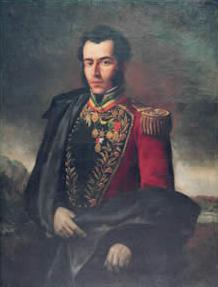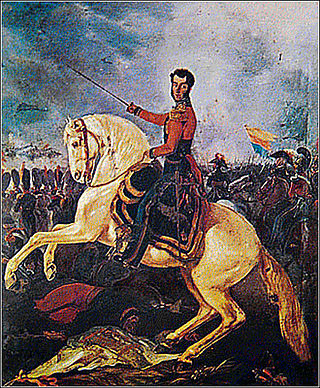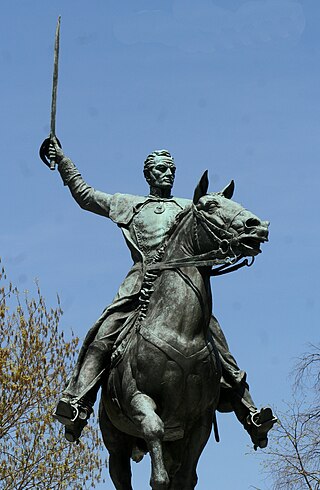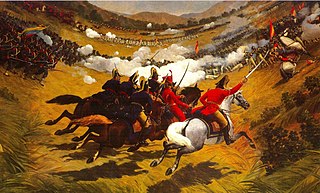This article needs additional citations for verification .(July 2018) |

The Sucre family is a prominent political family of Venezuela.
This article needs additional citations for verification .(July 2018) |

The Sucre family is a prominent political family of Venezuela.
The family was founded in Venezuela, by Carlos Francisco de Sucre Garrido y Pardo, a Flanders-born noble, son of Charles Adrien de Sucre y d'Yves, Marquess of Preux, of Flemish origin, and of María Buenaventura Carolina Isabel Garrido de Sánchez y Pardo de Figueroa, Lady of Syssele, of Spanish origin. Carlos Francisco de Sucre Garrido y Pardo, served as a soldier of Catalunya to the Spanish Crown in 1689, and was later named Governor of Cartagena de Indias and Governor and Captain General of Cuba. On 22 December 1779, the family arrived in Venezuela as Sucre Garrido y Pardo was appointed Governor of New Andalucia, the easternmost province of the then Captaincy General of Venezuela and where the family would remain for almost all its history. He married Margarita de Flores y Trelles and had a son Antonio Mauricio de Sucre Pardo y Trelles, married to Josefa Margarita Francisca García de Urbaneja y Sánchez de Torres, daughter of Francisco Manuel García de Urbaneja y Andrade and wife Teresa Sánchez de Torres y Gobea. Their son Vicente de Sucre y García de Urbaneja married María Manuela de Alcalá y Sánchez Ramírez de Arellano, daughter of Pedro de Alcalá y Rendón and wife Juana Jerónima Sánchez Ramírez de Arellano y Vallenilla, and their son was António José de Sucre y Alcalá.
Members of this family have excelled in modern Venezuelan history and have had a deep impact in that country's events. The most well-known member is General Antonio José de Sucre. He was a prominent figure in the Spanish American independence movement against Spain and is considered a founder of Bolivia, the liberator of Ecuador, and the Grand Marshal of Ayacucho. During the Spanish regime, he was originally appointed as a lieutenant in the provincial armed forces of the Venezuelan republics, serving under General Santiago Marino. [1] Sucre later became the first lieutenant to the liberator Simon Bolivar and was widely touted to replace Bolivar as the leader of the newly independent Latin American nations before his untimely death in the hands of royalist rebels in 1830. While Bolivar is described as the charismatic leader who rallied the independence forces to fight, historians recognize Sucre as the military genius behind him. [2]
Under Bolivar, he was involved in the purchase of armaments, issuing military orders, recruitment, and personnel assignments. Sucre also run a spy network against the royalists until they retreated [3] into the highlands southwest of Lima. Sucre is particularly famous for the Battle of Pichincha in 1822, where he quashed the Spaniards and liberated Ecuador. There is also the case of the Battle of Ayacucho, where he triumphed over Royalist army despite being vastly outnumbered. His forces sustained 309 dead and 607 wounded to the Royalists' 1,400 dead and 700 wounded. [3] His ability as a statesman was tested when he engaged in diplomatic missions, negotiating the armistice with Spain particularly in 1820. [1]
In the 20th century the family has once again become prominent in Venezuelan life as its members have taken roles in literature, politics, military and business. During the 1960s and 1970s the Sucre Figarella brothers were almost all involved in Venezuelan life serving in areas such as the military, public infrastructure, legislature, foreign service and literature. The oldest brother Juan Manuel Sucre was a general and served as Commander in Chief of the Army; his younger brother Leopoldo had the most active participation in politics as he was Governor and Senator of the state of Bolivar, Minister of Public Works, and as President of the state-owned Corporación Venezolana de Guayana; the third brother Jose Francisco was a key member of the foreign policy community serving as Ambassador to the United Nations and a number of European countries such as Russia and Austria. During the early half of the 20th century, another member of the family, José Antonio Ramos Sucre, had achieved fame as a great poet.
Nowadays, members of the family are mostly involved in private businesses.
The family coat of arms and its motto, in French, Contentez Vous de Sucre, is included in the 2,000 Venezuelan bolívar bill between 1994 and 1998.
Different places (and a former currency) across Latin America are named after Antonio José de Sucre, among them:
Some notable members of the Sucre family are:

Antonio José de Sucre y Alcalá, known as the "Gran Mariscal de Ayacucho", was a Venezuelan general and politician who served as the president of Bolivia from 1825 to 1828. A close friend and associate of Simón Bolívar, he was one of the primary leaders of South America's struggle for independence from the Spanish Empire.

The Bolivian War of Independence began with the establishment of government juntas in Sucre and La Paz, after the Chuquisaca Revolution and La Paz revolution. These Juntas were defeated shortly after, and the cities fell again under Spanish control. The May Revolution of 1810 ousted the viceroy in Buenos Aires, which established its own junta. Buenos Aires sent three large military expeditions to Upper Peru, headed by Juan José Castelli, Manuel Belgrano and José Rondeau, but the royalists ultimately prevailed over each one. However, the conflict grew into a guerrilla war, the War of the Republiquetas, preventing the royalists from strengthening their presence. After Simón Bolívar and Antonio José de Sucre defeated the royalists in northern South America, Sucre led a campaign that was to defeat the royalists in Charcas for good when the last royalist general, Pedro Antonio Olañeta, suffered death and defeat at the hands of his own defected forces at the Battle of Tumusla. Bolivian independence was proclaimed on 6 August 1825.

The military and political career of Simón Bolívar, which included both formal service in the armies of various revolutionary regimes and actions organized by himself or in collaboration with other exiled patriot leaders during the years from 1811 to 1830, was an important element in the success of the independence wars in South America. Given the unstable political climate during these years, Bolívar and other patriot leaders, such as Santiago Mariño, Manuel Piar, José Francisco Bermúdez and Francisco de Paula Santander often had to go into exile in the Caribbean or nearby areas of Spanish America that at the moment were controlled by those favoring independence, and from there, carry on the struggle. These wars resulted in the creation of several South American states out of the former Spanish colonies, the currently existing Venezuela, Colombia, Ecuador, Peru and Bolivia, and the now defunct Gran Colombia.

The Venezuelan War of Independence was one of the Spanish American wars of independence of the early nineteenth century, when independence movements in South America fought a civil war for secession and against unity of the Spanish Empire, emboldened by Spain's troubles in the Napoleonic Wars.
Sucre is the constitutional capital of Bolivia.

The Battle of Ayacucho was a decisive military encounter during the Peruvian War of Independence. This battle secured the independence of Peru and ensured independence for the rest of South America. In Peru it is considered the end of the Spanish American wars of independence in this country, although the campaign of Antonio José de Sucre continued through 1825 in Upper Peru and the siege of the fortresses Chiloé and Callao eventually ended in 1826.
Juan Manuel Sucre Figarella (1925-1996), was a Venezuelan army Brigadier General who served as Chief of Staff of the Venezuelan Army in the 1970s during the administration of President Rafael Caldera. He is a member of the Sucre family and a direct descendant of Vicente Vitto Luis Ramón de Sucre Pardo y García de Urbaneja, the father of the War of Independence hero Antonio José de Sucre.

The Gran Colombian–Peruvian War of 1828 and 1829 was the first international conflict fought by the Republic of Peru, which had gained its independence from Spain in 1821, and Gran Colombia, that existed between 1819 and 1830.

The Peruvian War of Independence was a series of military conflicts in Peru from 1809 to 1826 that resulted in the country's independence from the Spanish Empire. Part of the broader Spanish American wars of independence, it led to the dissolution of the Spanish Viceroyalty of Peru.

José María Córdova Muñoz, also known as the "Hero of Ayacucho", was a General of the Colombian army during the Independence War of Colombia, Perú, and Bolivia from Spain.

Pedro Blanco Soto was a Bolivian soldier and politician and president of the Republic of Upper Peru, an unrecognized entity that emerged in the limits of the department of La Paz and, which claimed the territory of the Republic of Bolivia. He held the position for a short time before being killed by his opponents in a convent called La Recoletta in Sucre on New Year's Day 1829. A small plaque now marks the spot in the Museo de la Recoletta. He was well known for his pro-Peruvian stance and this is generally the reason attributed to his assassination. He was also a distinguished officer during the Peruvian War of Independence.
Guillermo Sucre Figarella, was a Venezuelan poet and literary critic born in Tumeremo in the state of Bolivar. He was also a member of the Sucre family like his uncle Jose Antonio Ramos Sucre and his older brothers General Juan Manuel Sucre Figarella, and Senator Leopoldo Sucre Figarella.

Pedro Antonio de Olañeta y Marquiegui was a Royalist commander in the army of the Spanish Empire who fought against the South American insurgency led by Simón Bolívar. His support for Spanish absolutism and rebellion against the moderate Royalists created conflicts within the Royalist army that aided the rebels. After the defeat of the main Royalist armies, he continued the resistance, becoming one of the last Royalist commanders to hold out. Olañeta was the last Viceroy of the Río de la Plata.

Bolivia's independence was definitively proclaimed on 6 August 1825 at a congress held in Chuquisaca.
This is a timeline of events related to the Spanish American wars of independence. Numerous wars against Spanish rule in Spanish America took place during the early 19th century, from 1808 until 1829, directly related to the Napoleonic French invasion of Spain. The conflict started with short-lived governing juntas established in Chuquisaca and Quito opposing the composition of the Supreme Central Junta of Seville. When the Central Junta fell to the French, numerous new Juntas appeared all across the Americas, eventually resulting in a chain of newly independent countries stretching from Argentina and Chile in the south, to Mexico in the north. After the death of the king Ferdinand VII, in 1833, only Cuba and Puerto Rico remained under Spanish rule, until the Spanish–American War in 1898.

Bolivia–Spain relations are the current and historical relations between Bolivia and Spain. Both nations are members of the Association of Spanish Language Academies, Organization of Ibero-American States and the United Nations.

María Ana Carcelén de Guevara y Larrea-Zurbano, 5th Marquise of Villarocha and 7th Marquise of Solanda was an Ecuadorian aristocrat and the wife of the Venezuelan independence leader Antonio José de Sucre. She is considered the First Lady of Bolivia.

The October 9 Revolution was a successful revolt against the Spanish Empire in Guayaquil on October 9, 1820. It was led by the General Antonio José de Sucre and directed by Simón Bolívar. The revolt established a revolutionary junta and created the Free Province of Guayaquil, an independent state. The independence of Guayaquil revived the war of independence of the Real Audiencia de Quito as part of the Spanish American wars of independence. Prominent events in the revolution include the uprising of the Spanish garrison in the city of Guayaquil and the control of the Pacific by the Liberating Expedition of Peru, under the command of José de San Martín.

Hilario Remigio Rivas Reynolds was a Bolivian military officer and Commander of the Bolivian Army during the presidency of José María Pérez de Urdininea. He was a loyal supporter of Andrés de Santa Cruz and would be one of the only military officers not to desert him before the Battle of Yungay.

The Pasto Campaign was a series of military operations carried out between 1822 and 1824 by Gran Colombia against the Royalist strongholds of San Juan de Pasto and Patía, Cauca in present-day Southern Colombia.